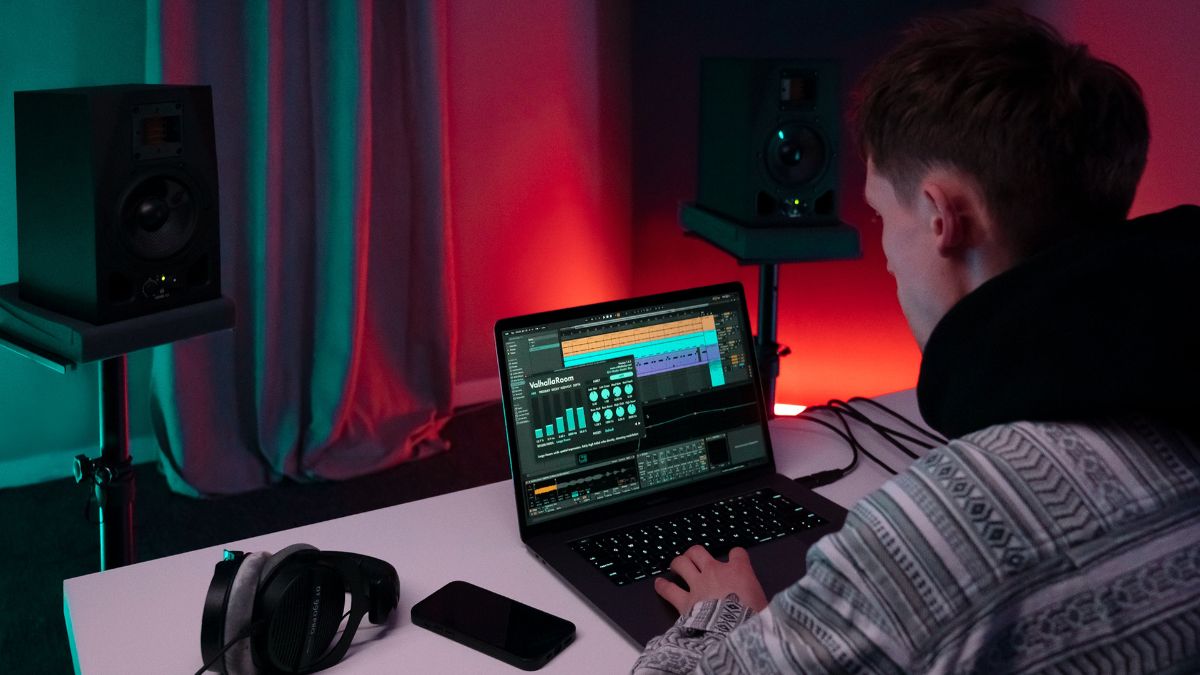Home>Production & Technology>Remix>How To Lofi Remix A Song


Remix
How To Lofi Remix A Song
Modified: January 22, 2024
Learn how to create a captivating lofi remix of your favorite songs with our step-by-step guide. Transform your tracks into unique masterpieces today!
(Many of the links in this article redirect to a specific reviewed product. Your purchase of these products through affiliate links helps to generate commission for AudioLover.com, at no extra cost. Learn more)
Table of Contents
Introduction
Welcome to the world of lofi remixing! In this article, we’ll explore the art of transforming a song into a lofi masterpiece. Whether you’re an aspiring music producer or simply a fan of the hazy, nostalgic vibes of lofi music, this guide will walk you through the steps to create your own unique lofi remix.
So, what exactly is a lofi remix? Lofi, short for “low fidelity,” refers to a genre of music characterized by its warm, muffled sound and vintage aesthetics. Lofi remixing involves taking an existing song and giving it a lofi makeover, infusing it with elements like vinyl crackle, tape hiss, and distorted drums.
Remixing has become a popular form of expression in the digital age, enabling artists and enthusiasts to put their own creative spin on existing songs. With the rise of platforms like SoundCloud and YouTube, lofi remixes have gained significant traction, providing a soothing and relaxing alternative to mainstream music.
Creating a lofi remix allows you to become a sonic alchemist, taking familiar melodies and transforming them into something entirely new and captivating. It’s a combination of technical skills and artistic sensibility, where you can experiment with various production techniques to achieve the signature lofi sound.
Now that you have an understanding of what a lofi remix is, let’s dive into the process of creating one. We’ll cover everything from song selection and isolation of instrumental tracks to adding lofi elements, applying effects, and finally, mixing and mastering your remix. By the end of this guide, you’ll be equipped with the knowledge and tools to craft your own mesmerizing lofi remixes.
What is a Lofi Remix?
Lofi remixing is the art of taking a song and giving it a lofi treatment, transforming it into a unique and atmospheric rendition. Lofi music, known for its warm, nostalgic sound and vintage aesthetics, has gained popularity in recent years, with remixes playing a significant role in shaping the genre.
At its core, a lofi remix takes the essence of a song and infuses it with lofi elements to create a relaxed, laid-back vibe. This involves introducing elements like vinyl crackle, tape hiss, and subdued drums to give the remix a sense of depth and character. Lofi remixing is often associated with genres such as hip-hop, jazz, and electronic music, but it can be applied to any genre to add a touch of vintage charm.
One of the key aspects of a lofi remix is the deliberate reduction in sound quality, creating a “low fidelity” aesthetic. This is achieved through techniques like filtering, EQ adjustments, and use of audio processing effects such as saturation and distortion. These techniques help recreate the nostalgic sound of old vinyl recordings and evoke a sense of nostalgia in the listener.
While a lofi remix may retain some elements of the original song, the goal is to transform it into something entirely new and captivating. This could involve rearranging the arrangement, adding new instrumentation, or manipulating the tempo and pitch to fit the desired lofi vibe.
Additionally, lofi remixing often incorporates ambient and atmospheric elements, such as field recordings, subtle background noises, and soothing textures. These elements help create a sense of space and immersion, enhancing the overall listening experience.
Overall, a successful lofi remix captures the essence of the original song while infusing it with the hazy, nostalgic feel that defines the lofi genre. It’s a creative and artistic process that allows producers to put their own spin on existing music, transforming it into a unique and captivating lofi experience.
Finding the Right Song
The first step in creating a lofi remix is finding the right song to work with. While any song can be remixed into a lofi version, certain songs lend themselves better to the lofi aesthetic. Here are some tips to help you find the perfect track:
- Choose songs with a melodic or catchy hook: Look for songs that have a memorable melody or a catchy hook. These elements will serve as the foundation of your lofi remix and make it easier to create a captivating rendition.
- Consider the song’s mood: Lofi music is known for its relaxed and nostalgic atmosphere. Look for songs that have a mellow or introspective mood, as they are more conducive to the lofi sound. Jazz, soul, and R&B tracks often work well in this regard.
- Experiment with different genres: While lofi remixing is commonly associated with certain genres like hip-hop and jazz, don’t limit yourself to these styles. Explore songs from different genres and experiment with remixing them into a lofi version. You might be surprised by the unique and interesting results.
- Consider the song’s arrangement: The arrangement of a song plays a significant role in how it can be transformed into a lofi remix. Look for songs that have clear sections, such as verses and choruses, as this will provide opportunities for creative remixing and restructuring.
- Listen for sample-friendly tracks: Lofi music often incorporates samples from various sources, such as old records or movies. When selecting a song, keep an ear out for sections that could be easily sampled and manipulated within your lofi remix.
Ultimately, the right song for your lofi remix is one that resonates with you and sparks your creativity. Trust your instincts and choose a track that you genuinely enjoy working with. This will ensure that you stay motivated throughout the remixing process and produce a remix that is true to your artistic vision.
Isolating the Instrumental Track
Once you have selected the song for your lofi remix, the next step is to isolate the instrumental track. This involves separating the vocals and other elements from the original song to create a version that focuses solely on the music. Here’s how you can do it:
- Check for an instrumental version: Before attempting to isolate the instrumental track, search for an existing instrumental version of the song. Many artists and record labels release instrumental versions of their tracks, which can save you time and effort. If you find a high-quality instrumental version, you can skip to the next step.
- Use phase cancellation: If an instrumental version is not available, you can try using phase cancellation to remove the vocals. This technique works by canceling out the audio information that is common between the left and right channels, which is typically the instrumental part. However, the effectiveness of this method depends on the quality of the original recording and may not always yield satisfactory results.
- Apply EQ and filtering: If phase cancellation doesn’t work or yields subpar results, you can use EQ and filtering techniques to reduce the prominence of vocals and other unwanted elements. Use an EQ plugin to cut out the frequencies where the vocals are most prominent and experiment with different settings until you achieve a good balance.
- Manual editing: In some cases, you may need to manually edit the audio file to remove or reduce the vocals. This can be time-consuming and requires a keen ear and some knowledge of audio editing software. Use tools like vocal isolation plugins, audio editing software, or even careful volume automation to selectively diminish the vocals while retaining the instrumental elements.
Remember, isolating the instrumental track completely is not always possible, especially if the vocals are mixed closely with other instruments. However, with careful EQing and filtering, you can minimize the vocals’ presence and create a version that leans towards the instrumental side.
Once you have successfully isolated the instrumental track, you can proceed to the next steps of the lofi remixing process, such as adjusting the tempo and pitch, adding lofi elements, and applying effects to achieve that nostalgic, atmospheric sound.
Adjusting the Tempo and Pitch
One of the key aspects of creating a captivating lofi remix is adjusting the tempo and pitch of the original song. These adjustments can completely transform the mood and vibe of the track, giving it that distinctive lofi sound. Here’s how you can make these adjustments:
- Lower the tempo: Lofi music is typically characterized by its slow and relaxed tempo. To achieve this, reduce the tempo of your chosen song. Experiment with different tempo settings to find the sweet spot that captures the desired lofi atmosphere. Be careful not to slow it down too much, as it can affect the natural flow and rhythm of the original track.
- Experiment with pitch shifting: Pitch shifting can add an interesting twist to your lofi remix. Lowering the pitch slightly can create a deeper, more laid-back feel, while raising the pitch can introduce a sense of playfulness or even nostalgia. Use pitch-shifting plugins or software to experiment with different pitch variations until you achieve the desired effect.
- Apply time-stretching: Time-stretching allows you to modify the duration of the song without affecting the pitch. This technique can be useful if you want to keep the original pitch intact but adjust the overall length of the song to fit the desired lofi aesthetic. Experiment with different time-stretching settings to find the right balance between tempo and pitch.
- Create variations: To add more depth and interest to your lofi remix, consider creating variations in tempo and pitch throughout the track. Introduce subtle changes or fluctuations at different sections to keep the listener engaged and create a dynamic listening experience. This can be achieved through manual adjustments or by using automation features in your digital audio workstation (DAW).
When adjusting the tempo and pitch, it’s important to consider the original key and musicality of the song. Keep in mind that drastic changes can alter the intended mood and emotional impact, so strive for a balance between transformation and maintaining the essence of the original composition.
By adjusting the tempo and pitch of the song, you can set the foundation for the lofi remix and establish the relaxed, nostalgic atmosphere that defines the genre. With these adjustments in place, you’re now ready to move on to the next steps of adding lofi elements, effects, and filtering to further enhance your remix.
Adding Lofi Elements
Now that you’ve adjusted the tempo and pitch of your selected song, it’s time to start adding the signature lofi elements that will give your remix that vintage, hazy charm. These elements can help to create a distinct atmosphere and enhance the overall lofi vibe. Here are some ideas to consider:
- Vinyl crackle and pops: Adding vinyl crackle and pops is a common technique to evoke a sense of nostalgia and simulate the warm, cozy feeling of listening to an old vinyl record. You can find vinyl crackle samples or use plugins that provide realistic vinyl emulation to add subtle crackling and pops throughout the remix.
- Tape hiss: Another characteristic sound associated with lofi music is tape hiss. This gentle, high-frequency noise is reminiscent of recordings made on analog tape machines. You can find tape hiss samples or use tape emulation plugins to insert subtle tape hiss into your remix, creating a vintage ambiance.
- Lo-fi drums: Lofi remixes often feature drums with a distinct lofi character. These drums are typically warm, slightly distorted, and often include vintage drum machine sounds. Experiment with different drum samples, apply light saturation or distortion to give them an old-school feel, and keep the drum patterns simple and laid-back.
- Musical samples: Incorporating musical samples is another way to add layers of texture to your lofi remix. Look for samples from old records, movies, or even field recordings that fit the mood and theme of your remix. Chop and manipulate the samples to create unique melodies or atmospheric loops that complement the original song.
- Chord progressions and melodies: Lofi music often revolves around simple and repetitive chord progressions and melodies. Experiment with different chord voicings, jazzy or soulful progressions, and minimalist melodies that flow well with the original song. These elements form the foundation of your remix and contribute to the overall lofi aesthetic.
Remember, the key to creating an engaging lofi remix is to strike a balance between adding these lofi elements and preserving the essence of the original song. These elements should enhance and complement the music rather than overpower it. Experimentation and creativity are crucial in finding the right combination that brings your lofi remix to life.
With the lofi elements incorporated, the remix will start to take shape, but there are still more steps to refine and elevate the lo-fi sound. In the next sections, we will explore how to enhance the remix with effects, adjust the EQ and filtering, and add vinyl crackle and background noise for that extra touch of authenticity.
Enhancing with Effects
Adding effects to your lofi remix can elevate the overall sound and help create the desired atmospheric and nostalgic vibe. Effects play a crucial role in shaping the sonic landscape of the remix. Here are some popular effects to consider:
- Reverb: Reverb is commonly used in lofi music to create a sense of space and depth. Experiment with different reverb settings to add a subtle, dreamy ambience to your remix. Use shorter decay times for a smaller room sound or longer decay times for a more spacious feel.
- Delay: Delay effects can add a lush, immersive quality to your remix. Try incorporating short slapback delays or longer, modulated delays to give certain elements of the mix a vintage character. Use subtle delay settings to avoid overwhelming the mix.
- Saturation and distortion: Saturation and distortion effects can enhance the warmth and character of your lofi remix. Apply gentle saturation to individual tracks or the final mix to add a touch of analog warmth. Experiment with different distortion plugins to achieve the desired vintage, gritty sound.
- Modulation effects: Modulation effects, such as chorus, flanger, and phaser, can add movement and interest to certain elements of your remix. Apply subtle modulation to instruments like guitars, keys, or even vocals to create a unique and vintage-inspired sound.
- Filtering: Use high-pass and low-pass filters to shape the frequency content of your mix. Applying a gentle high-pass filter can remove unnecessary low-end rumble, making the mix cleaner. On the other hand, a low-pass filter can soften high frequencies and create a more vintage and muffled sound.
Remember, the key is to use effects tastefully and sparingly. The goal is to enhance the mix, not overpower it or distract from the original mood of the song. Pay attention to the interaction between the effects and the different elements in the mix to maintain a cohesive and balanced sound.
As you experiment with different effects, it’s important to trust your ears and rely on your creativity. Don’t be afraid to push the boundaries and try unconventional combinations to achieve a unique and captivating lofi sound. It’s through this experimentation that you’ll discover unexpected sonic textures and create your own signature style.
With the effects applied, the next step is to fine-tune the overall sound by adjusting the EQ and filtering. This will further enhance the lofi character of the remix and ensure that each element sits well in the mix. Keep reading to learn more!
Adjusting the EQ and Filtering
When remixing a song into a lofi style, adjusting the EQ and filtering is crucial to sculpting the desired sound. These techniques allow you to shape the frequency balance, remove unwanted frequencies, and enhance the vintage, mellow characteristics of the remix. Here are some tips to help you with EQ and filtering:
- Low-end control: Lofi music often features a subdued and rounded low-end. Use a high-pass filter to remove unnecessary low frequencies from individual tracks or the overall mix. This helps to clean up the mix and create more space for other elements to shine.
- Vintage warmth: To add warmth and a nostalgic feel, enhance the lower mid-range frequencies around 200-400Hz. This can be done by using a gentle boost with a narrow Q (bandwidth) on instruments like guitars, keys, and background elements.
- Reducing harshness: Lofi music is generally characterized by soft, mellow tones. To reduce any harsh or piercing frequencies, use a gentle cut in the higher frequency range (around 2-4kHz). This can help create a smoother and more pleasing sound.
- Experiment with shelving EQ: Shelving equalizers are effective in adding overall tonal balance to the mix. By subtly boosting or cutting the high or low frequencies with a shelving EQ, you can enhance the desired lofi characteristics and achieve a vintage sound.
- Individual track EQ: Pay attention to the EQ of each individual track in your remix. For example, if you have a vocal track, you might want to emphasize the presence and clarity by boosting the midrange frequencies. Experiment with different EQ settings to make each element fit harmoniously in the overall mix.
- Use gentle filtering: In addition to EQ, consider using gentle filtering to further shape the sound. Experiment with low-pass and high-pass filters to remove unwanted frequencies or to create a more subdued and vintage feel. Be mindful of the impact on the overall mix balance as you apply these filters.
Remember, the goal of adjusting the EQ and filtering is to enhance the lofi aesthetic and create a pleasing sonic experience. Don’t go overboard with extreme EQ settings or filtering, as it can negatively impact the original musicality of the song. Subtle adjustments are often more effective in achieving the desired lofi sound.
Finally, trust your ears. Take the time to listen critically and make tweaks as needed. A well-balanced and pleasing EQ and filtering can significantly impact the overall quality of your lofi remix. Once you have dialed in the EQ and filtering, it’s time to add the finishing touches with vinyl crackle and background noise.
Adding Vinyl Crackle and Background Noise
One of the hallmark characteristics of lofi music is the presence of vinyl crackle and background noise. These elements help to recreate the nostalgic and vintage feel of listening to music on old vinyl records. Adding vinyl crackle and background noise to your lofi remix can further enhance the authenticity and atmosphere. Here’s how you can do it:
- Vinyl crackle samples: Start by finding high-quality vinyl crackle samples. These can be found in various sample packs or through online resources. Select samples that closely match the style and intensity of the lofi sound you wish to achieve.
- Layering the vinyl crackle: Once you have your crackle samples, experiment with layering them throughout the mix. You can place them strategically to simulate the sound of a vinyl record playing in the background. Adjust the volume and panning of the crackle samples to create a realistic and immersive vinyl experience.
- Background noise: In addition to vinyl crackle, consider adding subtle background noise to your lofi remix. This can include gentle white noise, tape hiss, or ambiance that helps create a vintage and atmospheric vibe. Similar to vinyl crackle, adjust the volume and panning of the background noise to avoid overpowering the core elements of your remix.
- Automation: To add a sense of variation and realism, consider automating the volume and other parameters of the vinyl crackle and background noise. You can create subtle changes in volume, panning, or even apply slight pitch modulation to mimic the imperfections and nuances of vinyl recordings.
- Integration with the mix: Pay attention to how the vinyl crackle and background noise sit within the mix. They should enhance the lofi atmosphere without overpowering the main elements of the remix. Use EQ and filtering techniques to shape the frequency content, ensuring that the crackle and noise blend seamlessly with the rest of the track.
By adding vinyl crackle and background noise, you not only enhance the authenticity of your lofi remix but also create a more immersive listening experience. It’s these subtle details that contribute to the charm and nostalgia that lofi music is known for.
Remember to exercise restraint when adding these elements. The goal is to create a balanced and cohesive mix, where the crackle and background noise enhance the overall lofi aesthetic without distracting from the core elements of the song. Trust your ears and fine-tune the levels and placement to achieve the desired effect.
With vinyl crackle and background noise incorporated into your remix, you’re now ready to move on to the final steps of mixing and mastering, where you will refine the overall sound and ensure that your lofi remix sounds polished and cohesive.
Mixing and Mastering the Remix
Once you have added all the desired elements and effects to your lofi remix, it’s time to focus on the crucial steps of mixing and mastering. Mixing involves balancing the levels, panning, and EQ of individual tracks to create an overall cohesive and well-balanced sound. Mastering, on the other hand, focuses on finalizing the mix and preparing it for distribution. Here’s how you can approach the mixing and mastering process for your lofi remix:
- Balance the levels: Start by ensuring that each element of the mix is appropriately balanced. Pay attention to the relative volume levels of different tracks to ensure that no element is overpowering or getting lost in the mix. Adjust the levels of individual tracks and utilize automation to emphasize important sections or elements of the song.
- Panning: Consider the placement of each instrument or element in the stereo field. Lofi music often features a wide and spacious sound, so experiment with panning to create a sense of depth and separation. Place instruments and effects in different positions to avoid overcrowding the center and provide space for each element to breathe.
- EQ and frequency balance: Fine-tune the EQ settings of individual tracks to achieve clarity and balance in the mix. Address any frequency clashes or masking issues by using EQ to carve out space for each element. Pay attention to the overall frequency balance, ensuring that the low, mid, and high frequencies are well-balanced and not overly exaggerated.
- Stereo imaging: Utilize stereo imaging techniques to create width and depth in the mix. Use stereo wideners or panning to widen select elements and create a more immersive experience. Be mindful not to overdo it, as excessive stereo widening can result in a loss of focus and coherence in the mix.
- Dynamic processing: Apply dynamic processing techniques such as compression and limiting to control the dynamics of the mix and achieve a consistent volume level. Use compression to tame any unruly peaks and ensure a more uniform sound. Apply limiting to achieve an overall loudness level that is competitive with other lofi tracks.
- Stereo and master bus processing: Consider applying light processing on the stereo and master bus to enhance the overall mix. This can include gentle EQ adjustments, subtle saturation, or stereo enhancement to further refine the lofi sound and cohesive character of the remix.
As you mix and master your lofi remix, it’s important to frequently reference similar tracks in the genre. This will help you gauge the overall sound, loudness, and tonal balance. Trust your ears and iterate on the process until you achieve the desired sound and level of professionalism.
Finally, don’t forget to take breaks during the mixing process to give your ears some rest. Returning with fresh ears can make a significant difference in making accurate judgments and adjustments to your mix. Once you are satisfied with the final mix, export it in a high-quality format suitable for distribution.
By following these mixing and mastering steps, you can ensure that your lofi remix sounds polished, cohesive, and ready to be shared with the world.
Conclusion
Congratulations on completing your journey into the world of lofi remixing! Throughout this article, we have explored the process of transforming a song into a captivating lofi masterpiece. From finding the right song and isolating the instrumental track to adjusting the tempo and pitch, adding lofi elements, and applying effects, each step has contributed to creating a unique and atmospheric lofi remix.
Remember that lofi remixing is both a technical and artistic endeavor. It requires a combination of technical skills, such as EQ and filtering, as well as a creative sensibility to infuse the remix with the nostalgic and hazy vibes that define the lofi genre.
As you continue to experiment and refine your lofi remixing techniques, don’t be afraid to push the boundaries and explore new ideas. Innovation often arises from thinking outside the box and breaking away from the conventional norms. With time and practice, you’ll develop a unique style and sound that sets your lofi remixes apart.
Moreover, don’t forget the importance of trusting your ears and relying on your instincts. While SEO optimization is important for visibility, maintaining the artistic integrity of your work and creating an enjoyable listening experience should always be top priorities.
Now, armed with the knowledge and techniques outlined in this article, you can confidently embark on your own lofi remixing endeavors. Whether you’re producing music for personal enjoyment, sharing it with friends, or even pursuing a career in music production, lofi remixing offers a creative and fulfilling outlet to express your unique artistic vision.
So, what are you waiting for? Grab your favorite song, dive into the world of lofi remixing, and let your creativity flow. Happy remixing!











